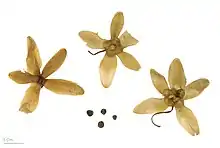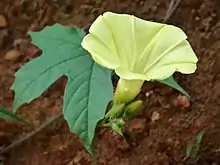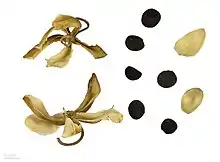Merremia
Merremia is a genus of flowering plants in the morning glory family, Convolvulaceae. Members of the genus are commonly known as woodroses.[3]
| Merremia | |
|---|---|
_in_Hyderabad%252C_AP_W_IMG_2527.jpg.webp) | |
| Merremia aegyptia growing in Hyderabad, India | |
| Scientific classification | |
| Kingdom: | Plantae |
| Clade: | Tracheophytes |
| Clade: | Angiosperms |
| Clade: | Eudicots |
| Clade: | Asterids |
| Order: | Solanales |
| Family: | Convolvulaceae |
| Genus: | Merremia Dennst. ex Endl.[1][2] |
| Species | |
|
See text | |
| Synonyms[2] | |

Merremia aegyptia - MHNT

Merremia vitifolia, Kerala

Merremia aurea - MHNT
Species
The following species are recognised in the genus Merremia:[4]
- M. aniseiifolia Ooststr. – hairy woodrose
- M. caloxantha (Diels) Staples & R.C.Fang
- M. calycina (Meisn.) Hallier f.
- M. calyculata Ooststr.
- M. candei (A.Terracc.) Sebsebe
- M. clemensiana Ooststr. – roadside woodrose
- M. cordata C.Y.Wu & R.C.Fang
- M. crassinervia Ooststr.
- M. dichotoma Ooststr.
- M. discoidesperma (Donn.Sm.) O'Donell
- M. ellenbeckii Pilg.
- M. emarginata (Burm.f.) Hallier f.
- M. gallabatensis Hallier f.
- M. gemella (Burm.f.) Hallier f.
- M. gorinii Chiov.
- M. gracilis E.J.F.Campb. & Argent
- M. grandidentata (C.H.Thomps.) Staples & Simões
- M. gregorii Rendle
- M. hainanensis H.S.Kiu
- M. hederacea (Burm.f.) Hallier f. (type) – ivy woodrose
- M. hemmingiana Verdc.
- M. hirta (L.) Merr.
- M. hornbyi Verdc.
- M. incisa (R.Br.) Hallier f.
- M. malvifolia Rendle
- M. martini (H.Lév.) Staples & Simões
- M. obtusa (Verdc.) Thulin
- M. palmata Hallier f.
- M. pavonii (Hallier f.) D.F.Austin & Staples
- M. platyphylla (Fernald) O'Donell
- M. poranoides (C.B.Clarke) Hallier f.
- M. porrecta Pilg.
- M. pterygocaulos (Choisy) Hallier f.
- M. rajasthanensis Bhandari
- M. retusa (Baker) Manitz – rock rosemary
- M. setisepala Verdc.
- M. sibirica (L.) Hallier f.
- M. spongiosa Rendle
- M. steenisii Ooststr.
- M. subsessilis (Courchet & Gagnep.) T.N.Nguyen
- M. thorelii (Gagnep.) Staples
- M. truncata Verdc.
- M. verdcourtiana Lejoly & Lisowski
- M. verecunda Rendle
- M. verruculosa S.Y.Liu
- M. warderensis Sebsebe.
- M. wurdackii D.F.Austin & Staples
- M. xanthophylla Hallier f.
- M. yunnanensis (Courchet & Gagnep.) R.C.Fang
Formerly placed here
- Operculina turpethum (L.) Silva Manso (as M. turpethum (L.) Rendle)
- Xenostegia medium (L.) D.F.Austin & Staples (as M. medium (L.) Hallier f.)
- Xenostegia tridentata (L.) D.F.Austin & Staples (as M. tridentata (L.) Hallier f.)[5]
Uses
In the Indigenous system of Medicine, Ipomoea reniformis chois is also known as Merremia emarginata (Burm.f.) Hallier f. has been claimed to be useful for cough, headache, neuralgia, rheumatism, diuretic, inflammation, fever due to enlargement of liver and also in kidney diseases. The tribal people use this plant for deobstruent, diuretic, rheumatism, neuralgia, cancerous wounds, migraine, purgative, snake bites, ulcer, abscesses and glandular swelling.
References
- The genus Merremia was originally described and published in Genera Plantarum 18: 1403. 1841. "Name - !Merremia Dennst. ex Endl". Tropicos. Saint Louis, Missouri: Missouri Botanical Garden (MOBOT). Retrieved January 7, 2013.
Type Specimens: T: Merremia hederacea (Burm.f.) Hallier f.
- GRIN (October 5, 2007). "Merremia information from NPGS/GRIN". Taxonomy for Plants. National Germplasm Resources Laboratory, Beltsville, Maryland: USDA, ARS, National Genetic Resources Program. Retrieved January 7, 2013.
Comment: conserved (nom. cons.) against the heterotypic synonyms (Vienna ICBN Art. 14.4 & App. III) Operculina Silva Manso, nom. rej. & the heterotypic synonym Camonea Raf., nom. rej.
- "Merremia". Integrated Taxonomic Information System. Retrieved 2011-04-12.
- "Merremia Dennst. ex Endl. | Plants of the World Online | Kew Science". Plants of the World Online. Retrieved 2020-04-16.
- GRIN. "Species in GRIN for genus Merremia". Taxonomy for Plants. USDA, ARS, National Genetic Resources Program. Retrieved January 7, 2013.
External links
- Dressler, S.; Schmidt, M. & Zizka, G. (2014). "Merremia". African plants – a Photo Guide. Frankfurt/Main: Forschungsinstitut Senckenberg.
Wikimedia Commons has media related to Merremia.
Wikispecies has information related to Merremia.
This article is issued from Wikipedia. The text is licensed under Creative Commons - Attribution - Sharealike. Additional terms may apply for the media files.